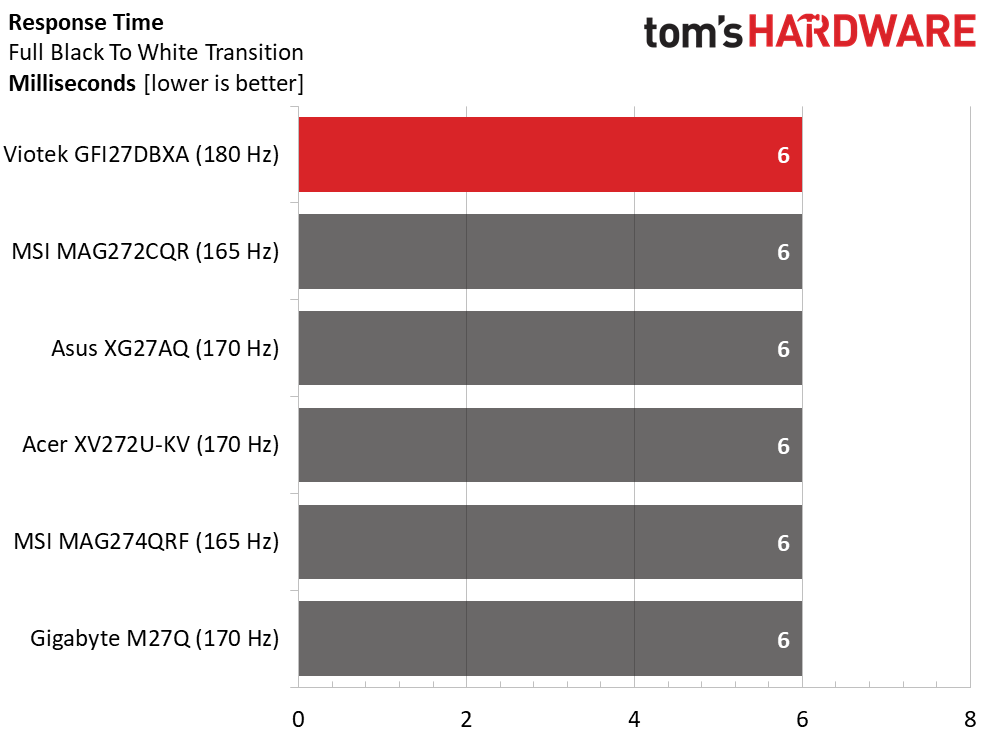Why you can trust Tom's Hardware
Viewing Angles

The GFI27DBXA responds like most IPS panels in our off-axis photos. But where most displays go green to the sides, the Viotek turns red. The shift is slight with a 30% reduction in brightness. From the top, the image becomes very red and light output is cut in half.
Screen Uniformity
To learn how we measure screen uniformity, click here.
Our GFI27DBXA sample had some visible glow in the corners of the screen. It was only visible in a full black pattern. Higher brightness patterns showed no problems. If you play a lot of dark games, you might be distracted by this, but for the majority of content, we were satisfied. Note that this is a sample-specific issue; other GFI27DBXAs may perform better in this test.
Pixel Response and Input Lag
Click here to read up on our pixel response and input lag testing procedures.


Though the GFI27DBXA has the highest refresh rate of the comparison group, it’s no faster than the rest. With a 6ms draw time, you won’t see any motion blur from any of these screens. We measured 28ms of total input lag, putting the Viotek in last place. This is a bit of a surprise, given its 180 Hz refresh rate.
But during actual gaming we couldn’t notice the difference and suspect other average gamers will feel the same. They should have no problem racking up frags and moving smoothly through game environments. Competitive players, however, should consider the MSI or Gigabyte displays though.
Get Tom's Hardware's best news and in-depth reviews, straight to your inbox.
Current page: Viewing Angles, Uniformity, Response and Lag
Prev Page HDR Performance Next Page Conclusion
Christian Eberle is a Contributing Editor for Tom's Hardware US. He's a veteran reviewer of A/V equipment, specializing in monitors. Christian began his obsession with tech when he built his first PC in 1991, a 286 running DOS 3.0 at a blazing 12MHz. In 2006, he undertook training from the Imaging Science Foundation in video calibration and testing and thus started a passion for precise imaging that persists to this day. He is also a professional musician with a degree from the New England Conservatory as a classical bassoonist which he used to good effect as a performer with the West Point Army Band from 1987 to 2013. He enjoys watching movies and listening to high-end audio in his custom-built home theater and can be seen riding trails near his home on a race-ready ICE VTX recumbent trike. Christian enjoys the endless summer in Florida where he lives with his wife and Chihuahua and plays with orchestras around the state.
-
waltc3 400 nits is actually very poor for HDR. It's at the very bottom of the HDR scale, actually. My current monitor is 1015 nits, DisplayHDR 1000 certified--and just off my previous 360 nits "HDR" monitor--I can tell you the comparison is night and day. If you want HDR support, look elsewhere, imo. Just thought I'd mention this as Windows HDR support is now actually pretty darn good these days (latest Win10 builds/Win11 betas). Game developers are at last getting the hang of it!Reply -
Jackson1078 So your monitor is brighter? Big deal. That still doesn’t change the fact that this monitor’s HDR implementation is a lot better then most in its price range and a good number above it. It will still deliver a solid result.Reply
